Last Updated on March 10, 2022
After driving the Golden Circle with its geysers and stunning waterfalls, traversing southern Iceland with its glaciers and black sand beaches, and marveling at the Eastern fjords, I wasn’t sure if the north of Iceland could top what we’d seen so far. But of course it could – this was Iceland after all, where you have scenic vistas everywhere you look. Ultimately, the north was the part of the country that had the highest density of awe-inspiring sights, and I am glad that our self-driving Iceland itinerary included a detour off the Ring Road which brought us to the Myvatn Peninsula. Most of the places that I consider highlights of northern Iceland are located on this little peninsula – like the grand Godafoss waterfall, the furiously fuming geothermal fields of Hverir or the rock formations of Dimmuborgir.
Ultimately, the north was the part of the country that had the highest density of awe-inspiring sights, and I am glad that our self-driving Iceland itinerary included a detour off the Ring Road which brought us to the Myvatn Peninsula. Most of the places that I consider highlights of northern Iceland are located on this little peninsula – like the grand Godafoss waterfall, the furiously fuming geothermal fields of Hverir or the rock formations of Dimmuborgir.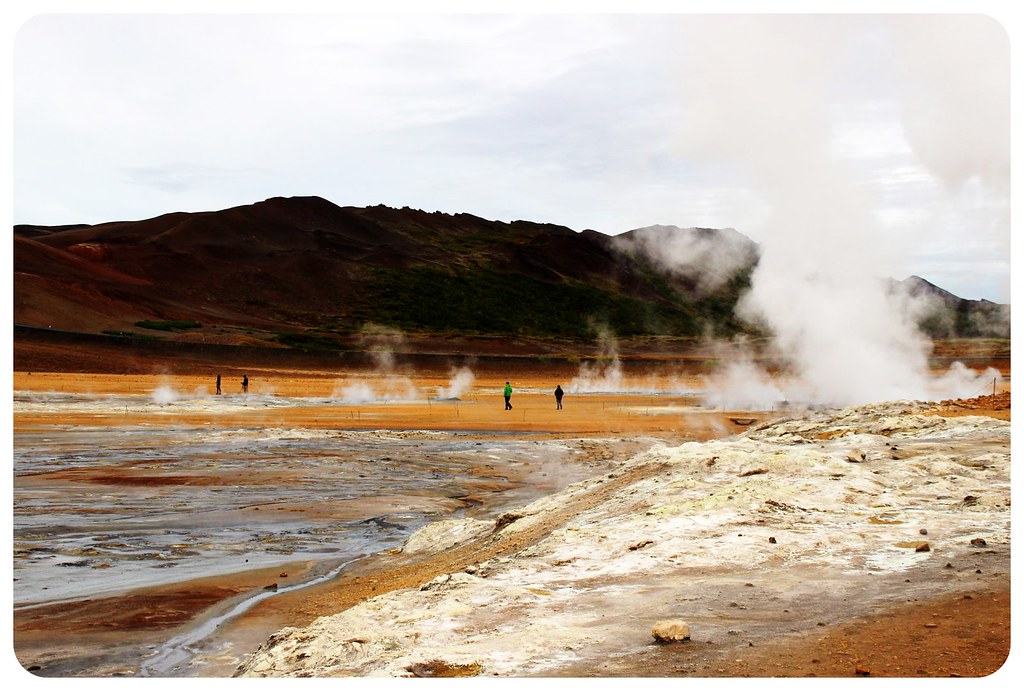 Because there are so many things to see in this area and because we also wanted to enjoy some hot springs (we opted for the Myvatn Nature Baths instead of the Blue Lagoon – I’ll be sharing why later on), we decided to spend an extra night in the Husavik area instead of moving on the very next day, like we’d done in all the other places we spent the night at.
Because there are so many things to see in this area and because we also wanted to enjoy some hot springs (we opted for the Myvatn Nature Baths instead of the Blue Lagoon – I’ll be sharing why later on), we decided to spend an extra night in the Husavik area instead of moving on the very next day, like we’d done in all the other places we spent the night at. After driving through the vast barren landscape that is the Möðrudalur valley, a place that is completely uninhabited and that made us feel as if we were driving on another planet, we left the Ring Road and turned right onto Road 864, which would bring us to Dettifoss waterfall, Asbyrgi Canyon to the fishing village of Husavik, and finally circle back down towards the Ring Road, to the small village of Laugar where we’d spend the night.
After driving through the vast barren landscape that is the Möðrudalur valley, a place that is completely uninhabited and that made us feel as if we were driving on another planet, we left the Ring Road and turned right onto Road 864, which would bring us to Dettifoss waterfall, Asbyrgi Canyon to the fishing village of Husavik, and finally circle back down towards the Ring Road, to the small village of Laugar where we’d spend the night.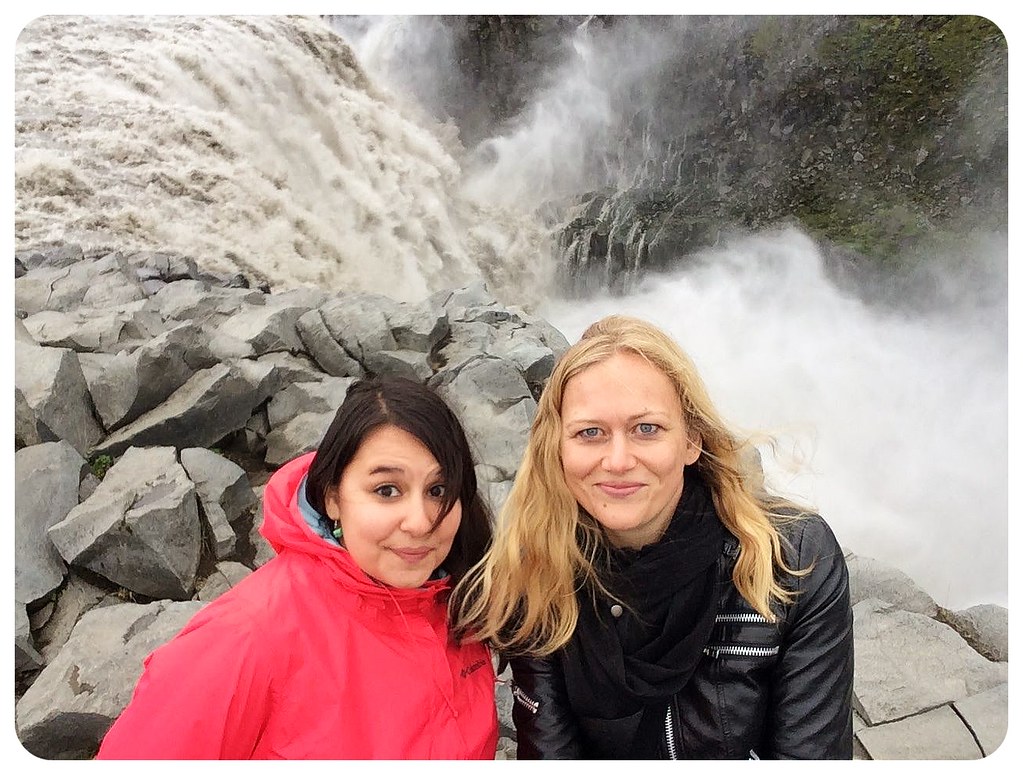
Dettifoss Waterfall
Upon leaving the Ring Road, we found ourselves on an unpaved road – the first time on our trip. I was surprised that the road to an attraction as big as Dettifoss wasn’t paved, but our Volkswagen rental did a great job, and renting a bigger car was absolutely not necessary for our route. Driving through no man’s land for hours made me realize what a sparsely populated country Iceland is – and without cell phone reception and barely any cars passing us I was praying to the vehicle gods that I wouldn’t get a flat tire up here.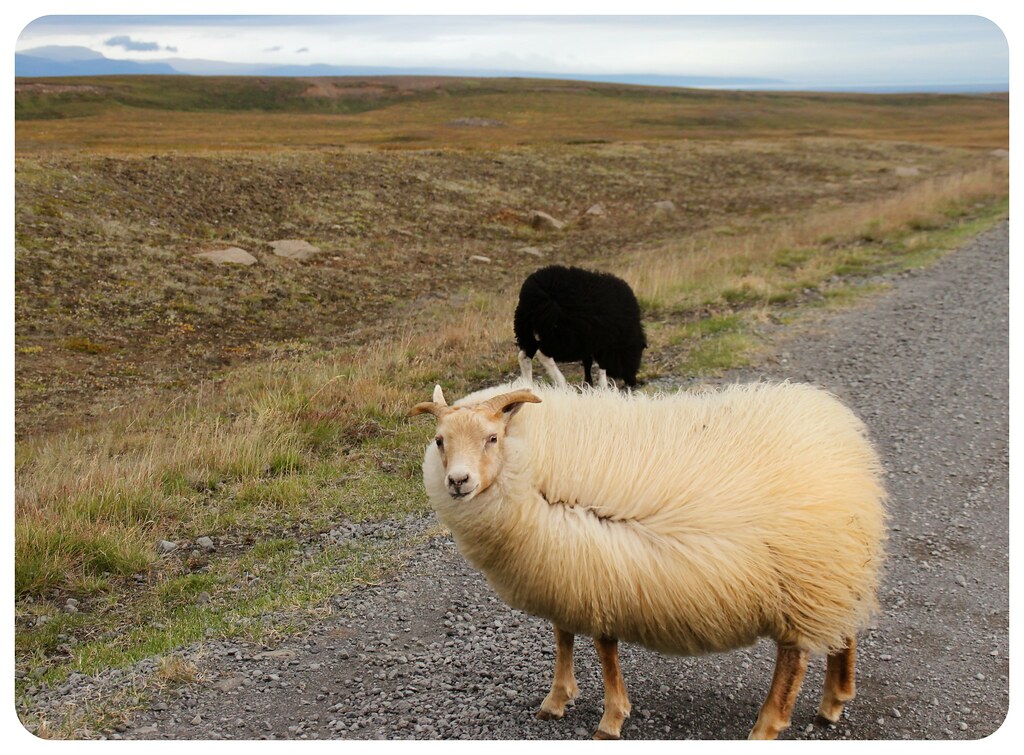 Who knows how many hours we’d have to wait until another car would come to our rescue? And we were glad that we had carefully read the itinerary Hey Island had provided us with, which breaks down day by day where you go and what you see, and that had warned us to fill up the tank because we wouldn’t pass a gas station for many, many miles – so we had made sure to fill up again at the gas station in Egilsstaðir, the last one before the desolate Möðrudalur Valley.
Who knows how many hours we’d have to wait until another car would come to our rescue? And we were glad that we had carefully read the itinerary Hey Island had provided us with, which breaks down day by day where you go and what you see, and that had warned us to fill up the tank because we wouldn’t pass a gas station for many, many miles – so we had made sure to fill up again at the gas station in Egilsstaðir, the last one before the desolate Möðrudalur Valley. The part of the drive along the unpaved road, after Möðrudalur Valley, was probably the least exciting of the entire trip, but that’s where my iPhone came in handy, which I had not only loaded with podcasts, but also with Aziz Ansari’s Modern Romance audiobook, and which kept us entertained during the many hours we spent in the car.
The part of the drive along the unpaved road, after Möðrudalur Valley, was probably the least exciting of the entire trip, but that’s where my iPhone came in handy, which I had not only loaded with podcasts, but also with Aziz Ansari’s Modern Romance audiobook, and which kept us entertained during the many hours we spent in the car.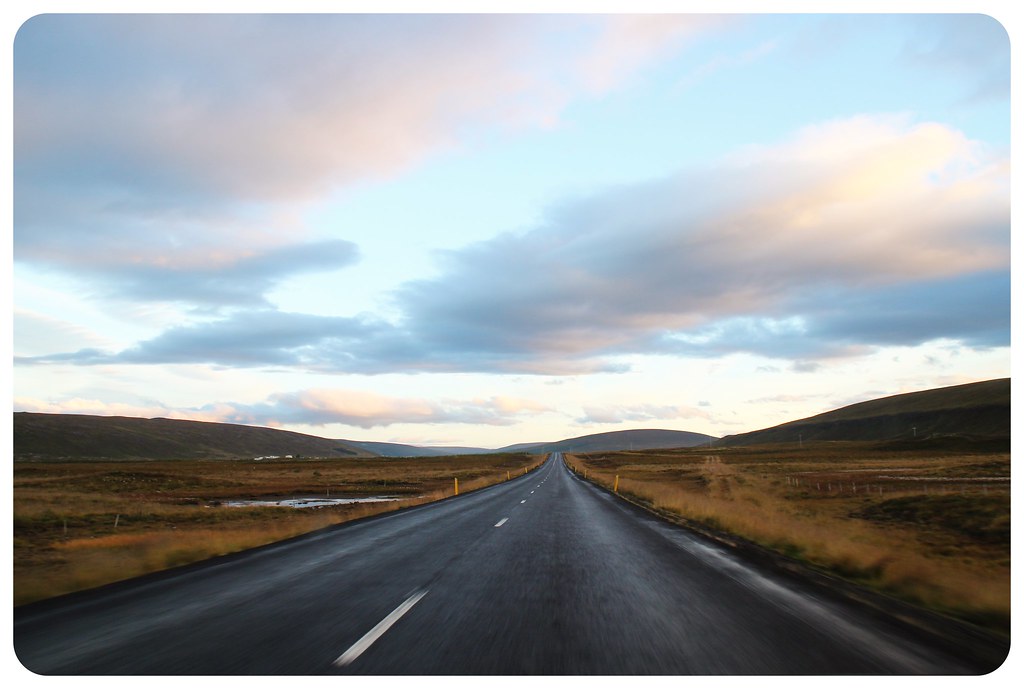 And finally there it was, the turn-off for Dettifoss, Europe’s most powerful waterfall. The enormous power of the waterfall was palpable as soon as we got closer. Every second, over 96,000 gallons (363,400 liters) of water plummet from the top of the falls to the bottom, onto the steep rocks that border the waterfall on both sides. Dettifoss, 148 feet (45 meters) high and 328 feet (100 meters) wide, wasn’t anything like the other waterfalls we’d seen in Iceland so far – until the very end, we never got tired of seeing waterfalls.
And finally there it was, the turn-off for Dettifoss, Europe’s most powerful waterfall. The enormous power of the waterfall was palpable as soon as we got closer. Every second, over 96,000 gallons (363,400 liters) of water plummet from the top of the falls to the bottom, onto the steep rocks that border the waterfall on both sides. Dettifoss, 148 feet (45 meters) high and 328 feet (100 meters) wide, wasn’t anything like the other waterfalls we’d seen in Iceland so far – until the very end, we never got tired of seeing waterfalls.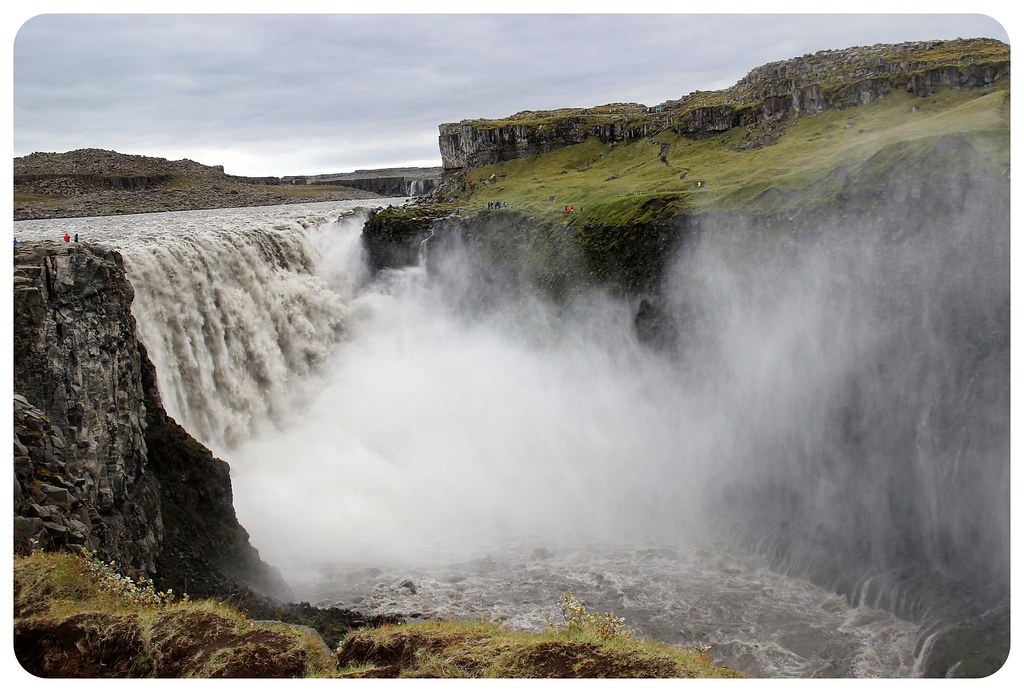 I also loved the Jökulsa Canyon, through which the Jökulsá á Fjöllum river runs. If we had more time, we could have gone for a walk along the steep cliffs of the canyon and enjoyed not only the views of Dettifoss, but also Selfoss, which is located just a few hundred meters upstream, and Hafragilsfoss, about two miles downstream from Dettifoss. To see all three waterfalls in one hike, plan on about three hours. The hiking paths along the gorge are clearly marked.
I also loved the Jökulsa Canyon, through which the Jökulsá á Fjöllum river runs. If we had more time, we could have gone for a walk along the steep cliffs of the canyon and enjoyed not only the views of Dettifoss, but also Selfoss, which is located just a few hundred meters upstream, and Hafragilsfoss, about two miles downstream from Dettifoss. To see all three waterfalls in one hike, plan on about three hours. The hiking paths along the gorge are clearly marked.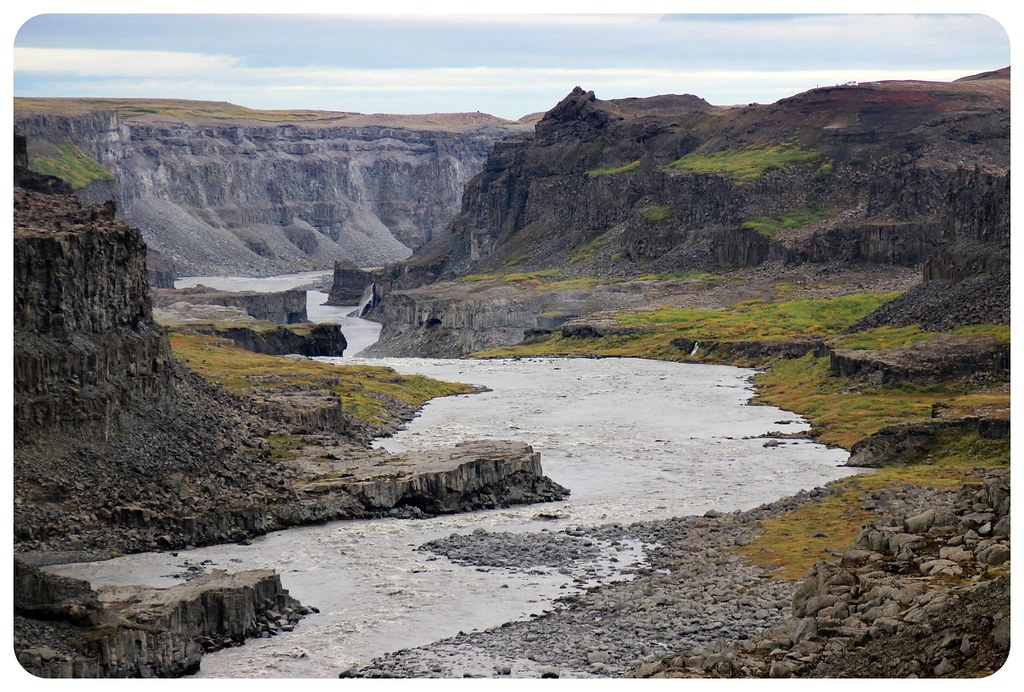
Asbyrgi Canyon
From here, it was onwards to Asbyrgi, a horseshoe shaped canyon, over 2 miles (3.5km) long, 0.6 miles (1 km) wide and 328 feet (100 meters) high. The canyon can be visited from above and from the bottom, and sadly we only made it to the bottom of the canyon, because it was getting too late and we still wanted to see the fishing village of Husavik before it got dark.
It would’ve been nice to have time to check out the hiking trails above the gorge, or you can even hike from Asbyrgi along Jökulsárgljúfur canyon all the way to Dettifoss, a two day hike that covers a total of around 22 miles (35 km). You can read more about that hike here. But if you only have a week to see Iceland, you have to sacrifice some things.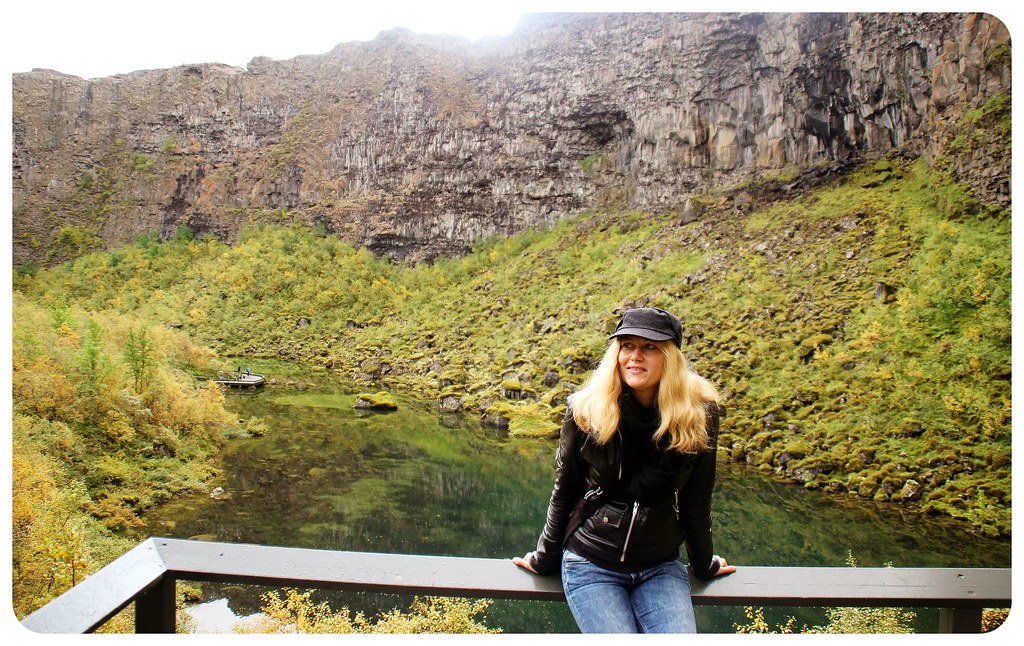 Seeing the canyon from below was still impressive, and we enjoyed the weird quietness of the place when we did a short hike through the woods to the silent ponds Botnstjorn and Leirtjorn at the bottom of the steep cliffs.
Seeing the canyon from below was still impressive, and we enjoyed the weird quietness of the place when we did a short hike through the woods to the silent ponds Botnstjorn and Leirtjorn at the bottom of the steep cliffs.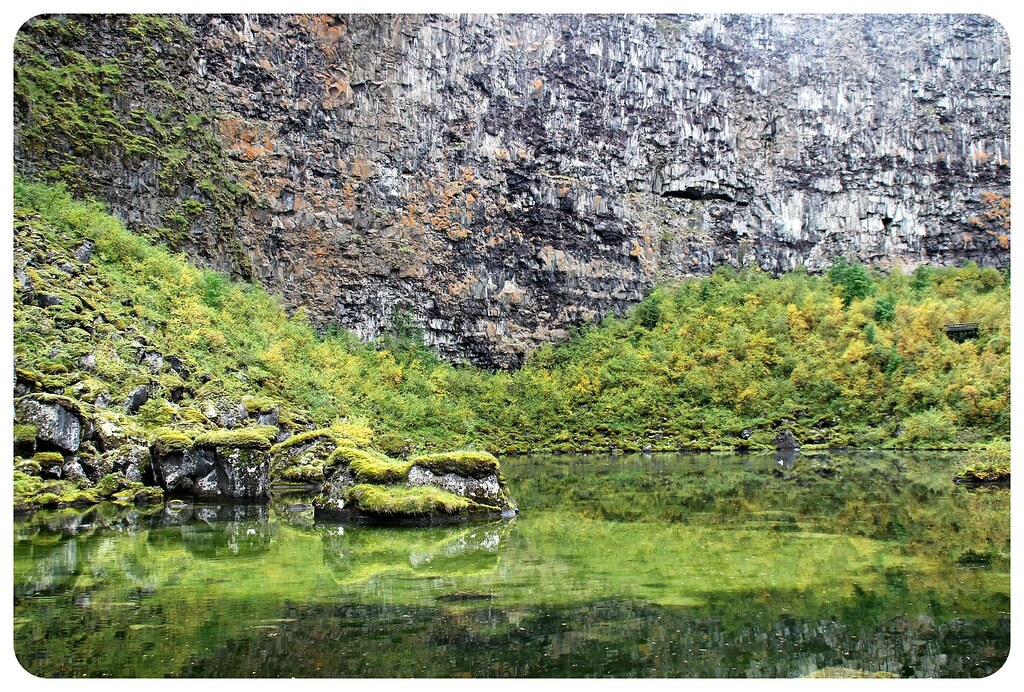 Another remarkable feature here was Eyjan, a colossal rock that rises up out of the ground across from the canyon. Only afterwards did I find out that it’s possible to climb Eyjan (follow the signs that say ‘Eyjan’ in the parking lot for the short hike there) for a panoramic view of Asbyrgi from the top of the rock.
Another remarkable feature here was Eyjan, a colossal rock that rises up out of the ground across from the canyon. Only afterwards did I find out that it’s possible to climb Eyjan (follow the signs that say ‘Eyjan’ in the parking lot for the short hike there) for a panoramic view of Asbyrgi from the top of the rock.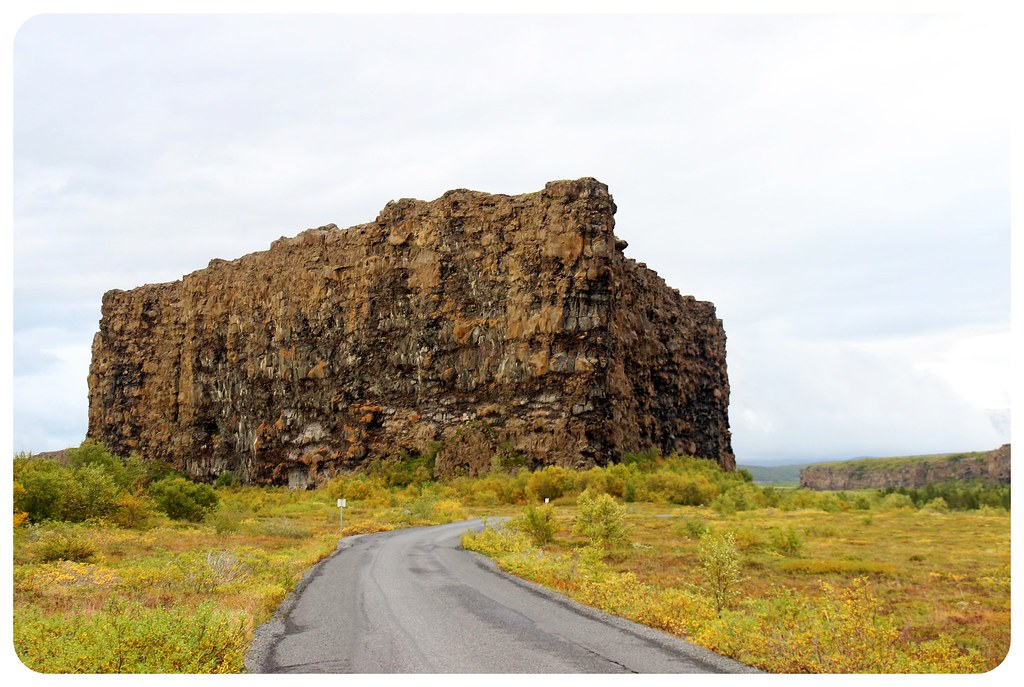 We reached Husavik just as the sun set. If you’re doing this drive during the winter months, when daylight hours are shorter, you might want to keep your roadside stops short or you will find yourself driving in the dark. I found myself driving the last few miles from Husavik to Laugar in the dark which I was fine with because by now, we were driving on a paved road again, but I am not sure how I would’ve felt in the dark on the unpaved road we’d driven most of the day on.
We reached Husavik just as the sun set. If you’re doing this drive during the winter months, when daylight hours are shorter, you might want to keep your roadside stops short or you will find yourself driving in the dark. I found myself driving the last few miles from Husavik to Laugar in the dark which I was fine with because by now, we were driving on a paved road again, but I am not sure how I would’ve felt in the dark on the unpaved road we’d driven most of the day on.
The Northern Lights
It was also here in the north of Iceland, in Laugar, where we finally saw the northern lights – it had been too cloudy the previous nights, and of course I was hoping to see the northern lights in Iceland! And when I peeked out of the window at around 12.30am, there they were, dancing right outside our window. I quickly woke up Rease and got dressed to photograph the lights outside. I ran to the car to grab my tripod, which I had lugged around for weeks just for this occasion, and in the process of setting it up, the little plastic holder for my camera broke off. There went my chance to photograph the Aurora Borealis.
However, I couldn’t be upset about this for too long, because seeing these bright green lights dancing across the night sky was spectacular. I decided that it was much more enjoyable to simply take in this incredible sight rather than getting frustrated about my camera’s not-so-great night photography capabilities and missing out on the moment over trying to get some decent pictures.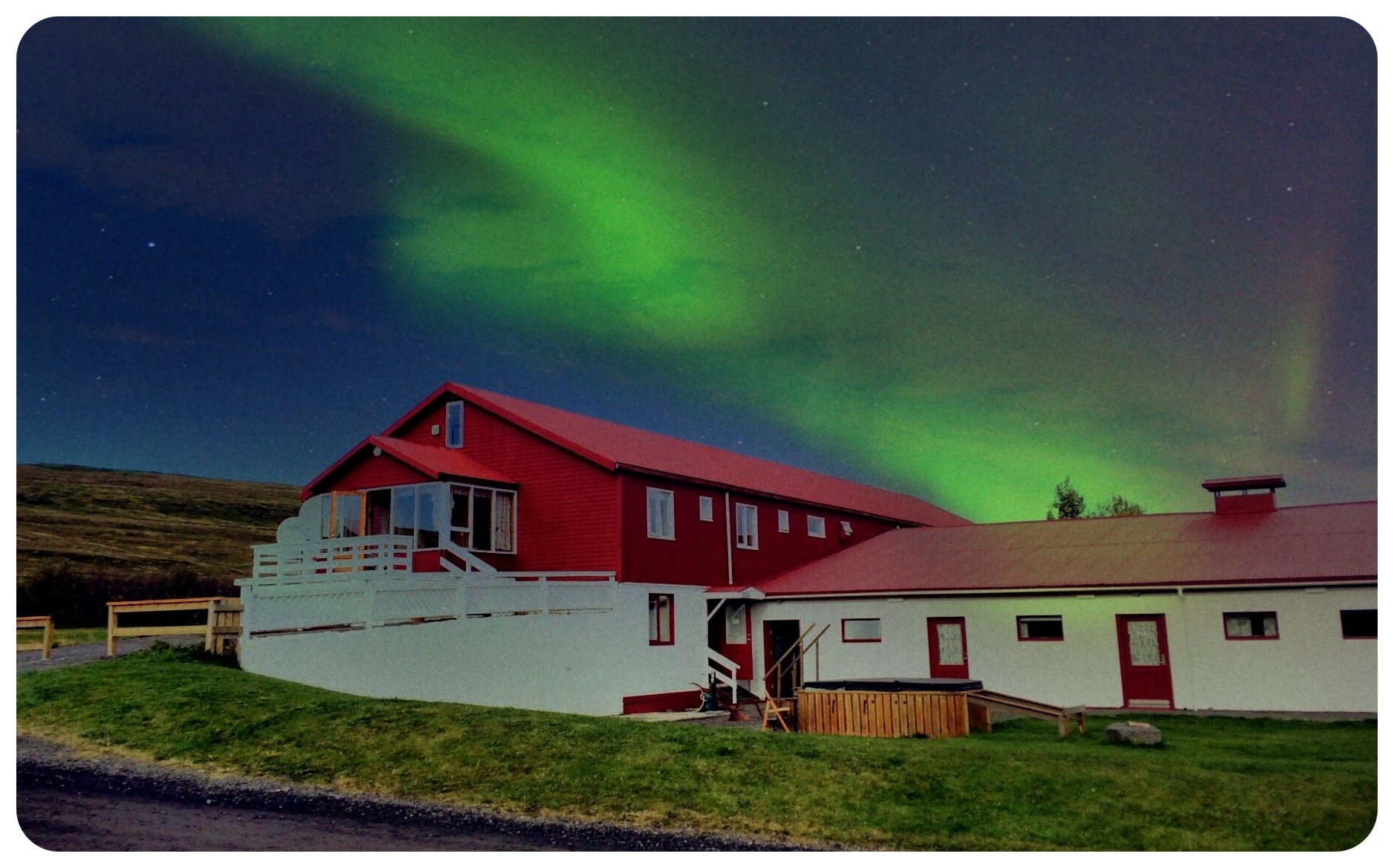 So yeah, this picture shows you what it looked like, but I can’t take credit for it (it is the farmhouse we were staying in).
So yeah, this picture shows you what it looked like, but I can’t take credit for it (it is the farmhouse we were staying in).
Lake Myvatn
The next morning, we hit the road early, because even though we were staying in Laugar again that night, we had a busy day ahead of us. On our way to our first destination of the day, the Dimmuborgir lava field, we already pulled over three or four times for photo stops. We were circling Lake Myvatn, a big lake that was formed during an eruption 2,300 years ago that has remained geothermally active ever since.
There were gorgeous photo opportunities around every turn, it seemed, and had it not been for the many flies that were following us around, it would have been a great spot for a hike along the shores, where you find abundant bird life (but we were too busy running from the dozens of flies that were chasing us… this was the only place in Iceland we even saw flies, it was very odd – something in the lake must attract them?).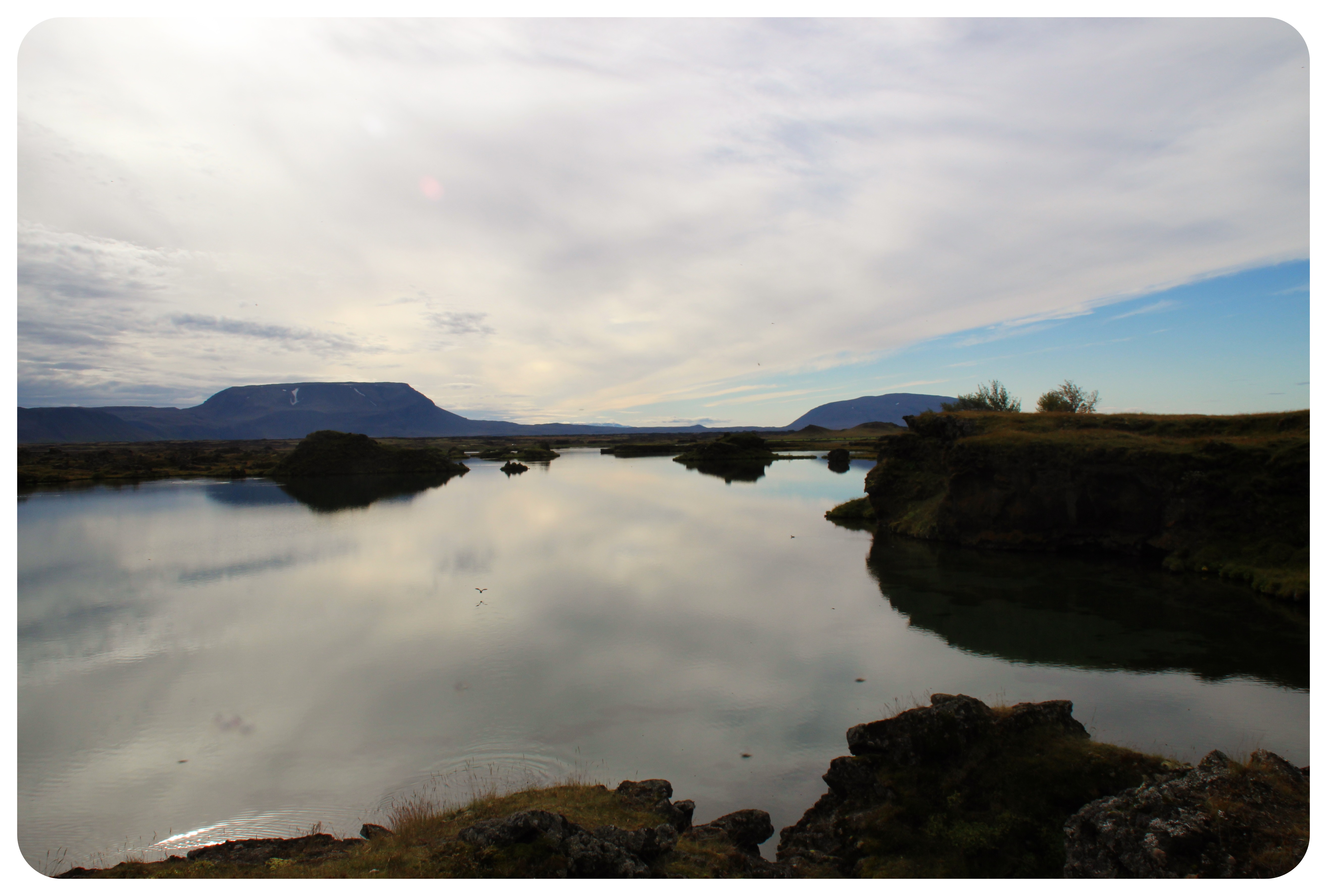
Dimmuborgir Lava Field
The rock formations of Dimmuborgir are part of a lava field like no other in the world: the huge lava rocks felt (yet again) completely otherworldly, but unlike anything else we’d seen in Iceland so far (or anywhere else in the world, as a matter of fact!). Some of the lava rocks rise out of the ground like skewed and bent pillars, some are shaped into arches and other quite bizarre formations. There are several hiking trails that lead right through the pillars and rocks, some of which you can climb and walk through (most of the rock formations cannot be climbed because the lava is quite fragile).
There are several hiking trails that lead right through the pillars and rocks, some of which you can climb and walk through (most of the rock formations cannot be climbed because the lava is quite fragile).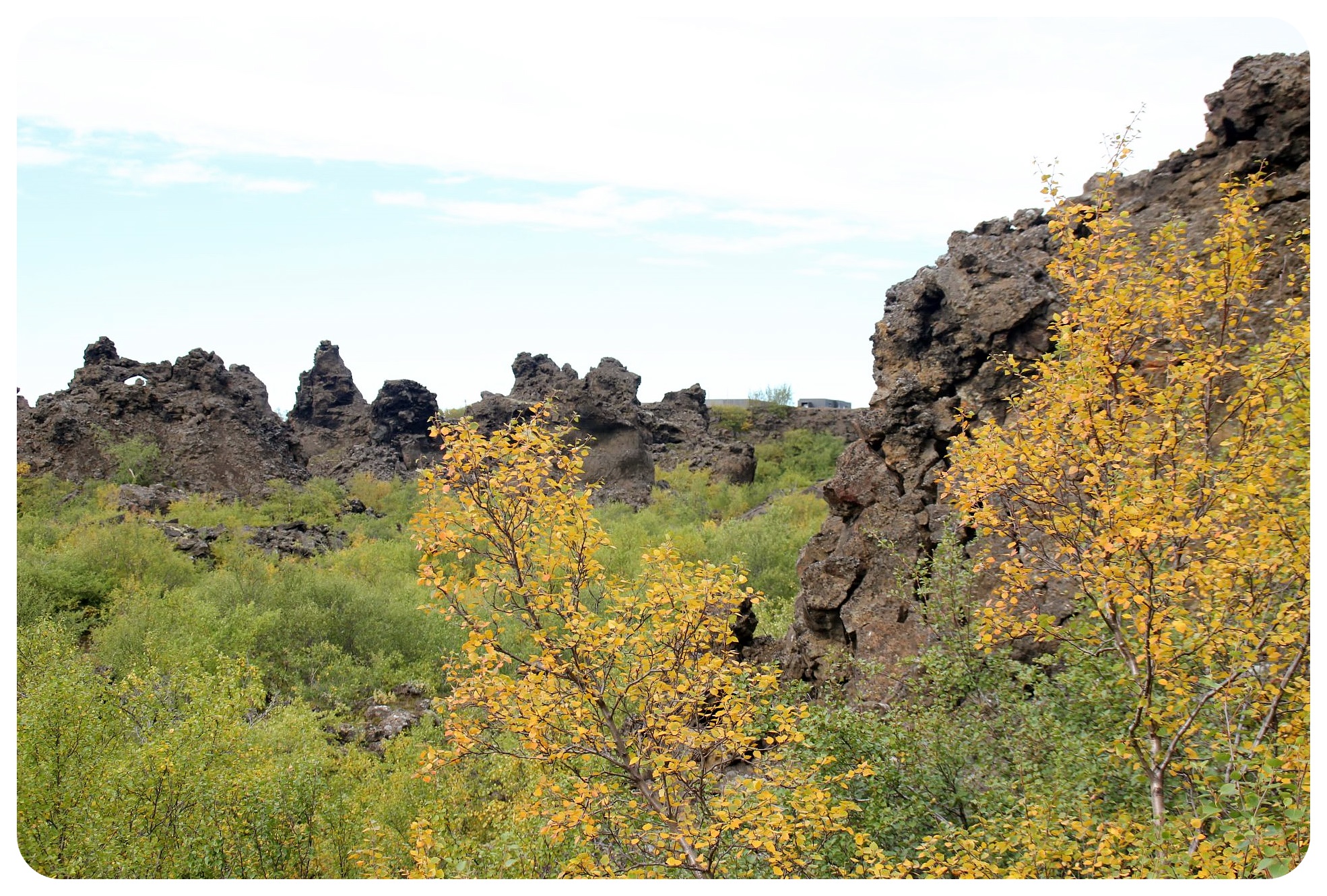 If you watch Game Of Thrones, you might recognize this place from the show, where it was used as a filming location in season three.
If you watch Game Of Thrones, you might recognize this place from the show, where it was used as a filming location in season three.
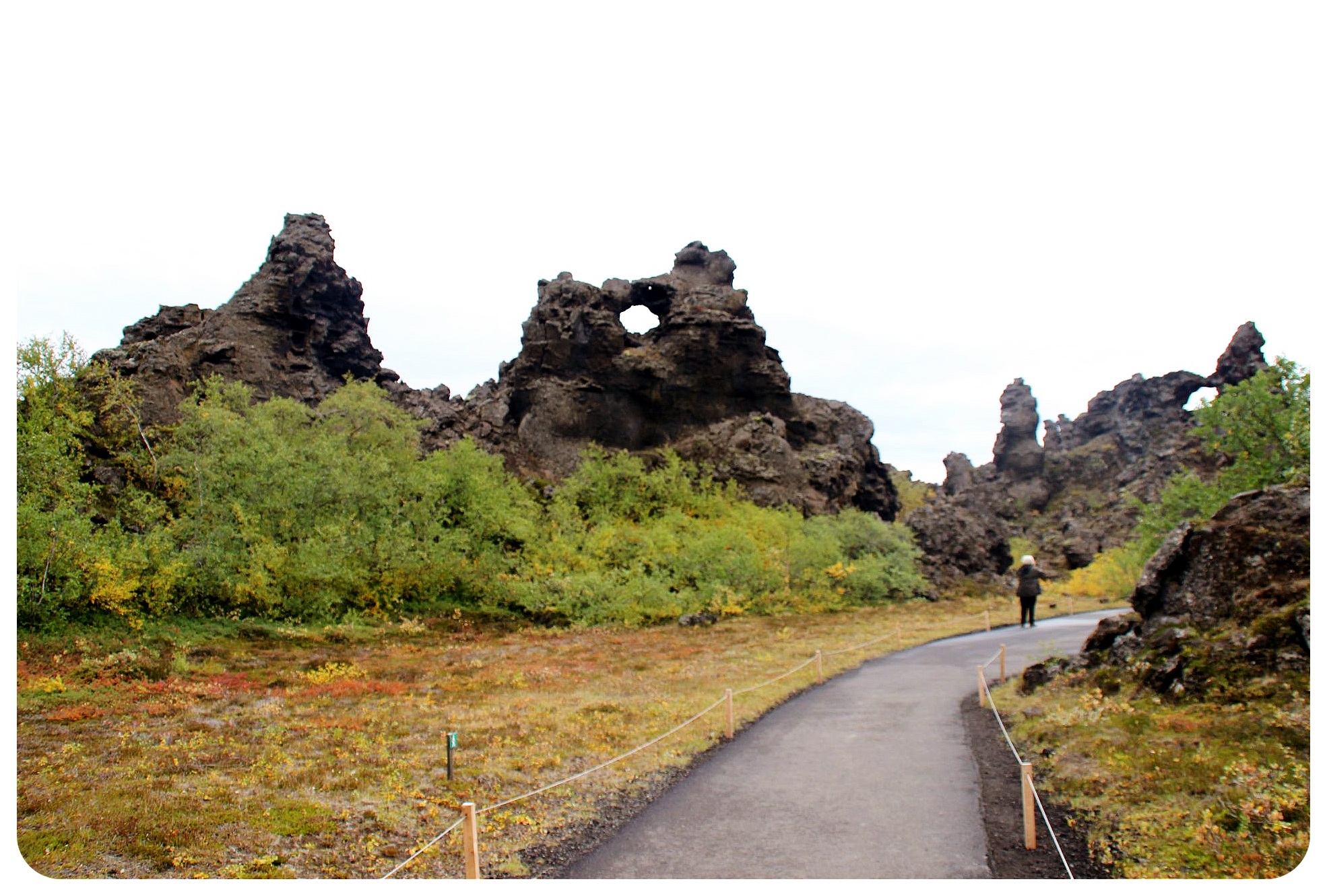
Hveraröndor Hverir geothermal fields
Our next destination? The geothermal fields of Hverir, which we could already spot from far away as we drove down the winding road from Námaskarð Pass towards the bright orange territory, out of which several steam vents were blowing big clouds high into the sky.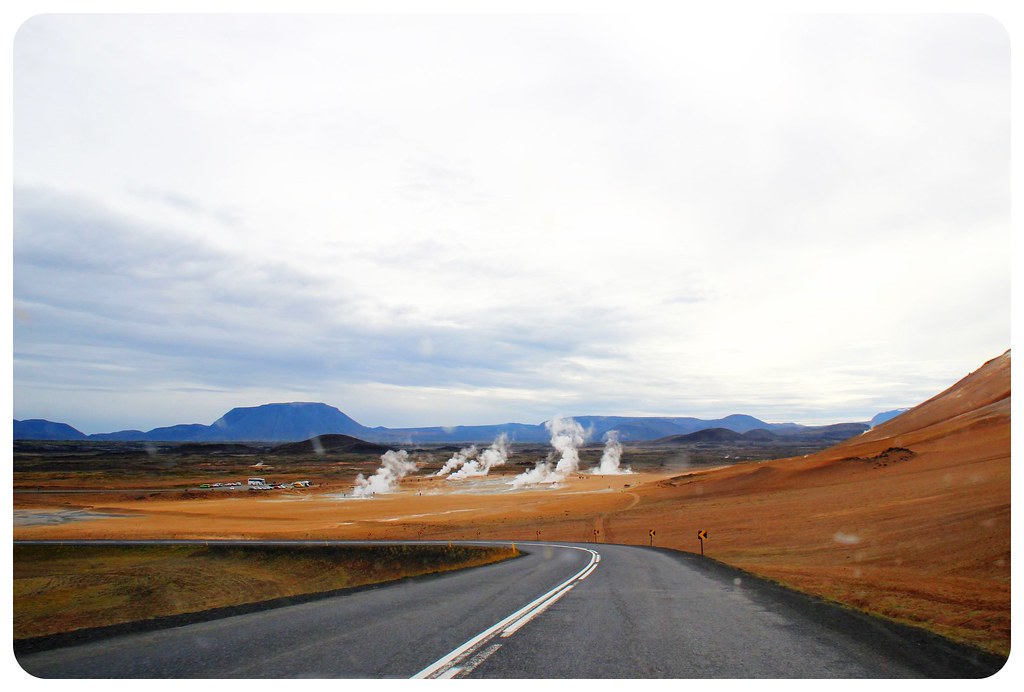 For me, the mix of steaming mounds and bubbling pools was one of the most fascinating sights in all of Iceland – it is so rare to find yourself surrounded by sulfurous mud springs and fumaroles emitting steam into the sky, walking over dry, cracked puddles of grey mud and trying not to get too close to the steam vents, which are so hot that you can easily get burnt just from standing too close to them.
For me, the mix of steaming mounds and bubbling pools was one of the most fascinating sights in all of Iceland – it is so rare to find yourself surrounded by sulfurous mud springs and fumaroles emitting steam into the sky, walking over dry, cracked puddles of grey mud and trying not to get too close to the steam vents, which are so hot that you can easily get burnt just from standing too close to them.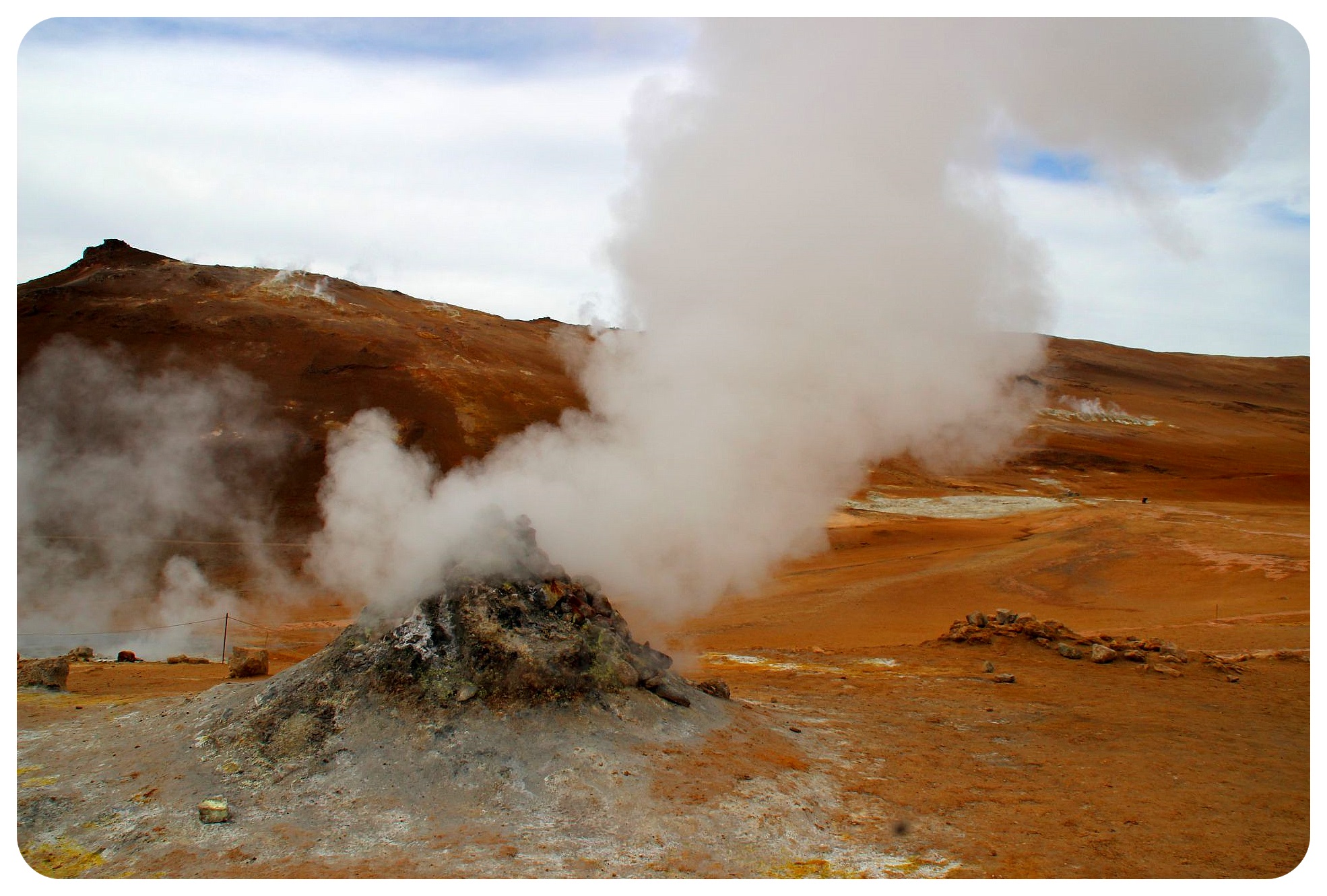 The barren scenery here, along with the bright colors of the soil, made me think once again: are we on a different planet? I could’ve spent hours photographing this place – had it not been for the rotten egg smell of the sulphur, which was almost unbearable in some places.
The barren scenery here, along with the bright colors of the soil, made me think once again: are we on a different planet? I could’ve spent hours photographing this place – had it not been for the rotten egg smell of the sulphur, which was almost unbearable in some places.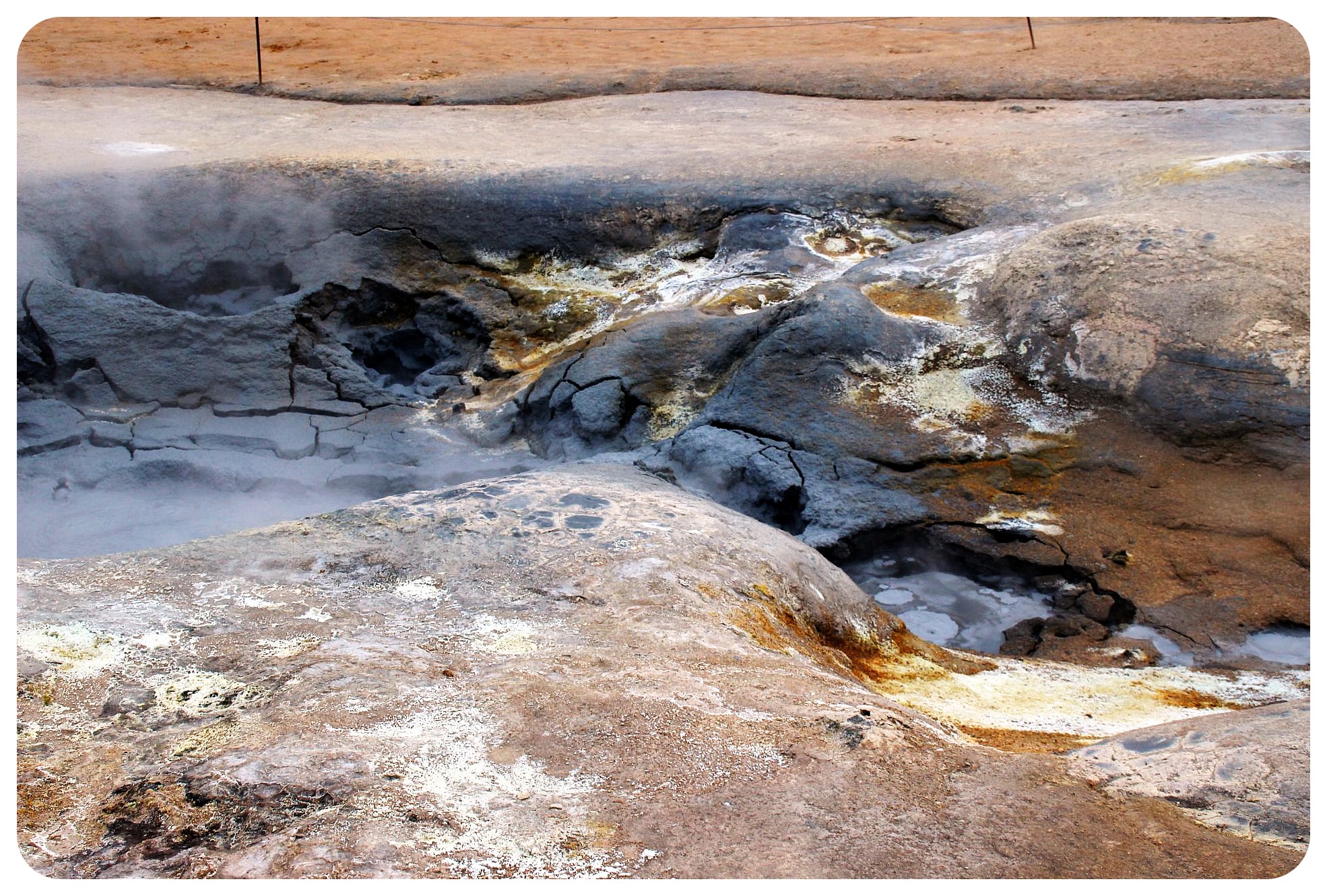
Myvatn Nature Baths
Our last stop for the day were the Myvatn Nature Baths, which turned out to be one of the highlights of the entire road trip for me. We had planned in an extra night in Myvatn specifically so that we’d have time for a relaxing soak in the mineral-rich waters. If you’re not a fan of baths and spas, you might still want to spend an extra night in this area, because Husavik in the north of the Myvatn peninsula is where the popular whale-watching boat tours leave from. Rease and I both agreed that the nature baths sounded more appealing than a chilly three hour boat ride through Arctic waters (I might still be scarred from my last whale watching trip off the coast of California… three of the most miserable hours of my life, and zero whales spotted). The Myvatn Nature Baths are often described as northern Iceland’s version of the Blue Lagoon, which sits in the southwest of the island, close to the airport and Reykjavik. However, we had both heard that the Blue Lagoon often gets crowded, and since it has become incredibly popular over the past few years, prices have also increased (admission to the Blue Lagoon starts at US$45 in the winter, $55 in the summer – and that’s without a drink!). I still want to check out the Blue Lagoon one day, because it looks fabulous, but with four times as many visitors as the Myvatn Nature Baths, I have a feeling it might feel too busy for me. To get a better idea of both the Blue Lagoon and the Myvatn Nature Baths, have a look at these articles:
The Myvatn Nature Baths are often described as northern Iceland’s version of the Blue Lagoon, which sits in the southwest of the island, close to the airport and Reykjavik. However, we had both heard that the Blue Lagoon often gets crowded, and since it has become incredibly popular over the past few years, prices have also increased (admission to the Blue Lagoon starts at US$45 in the winter, $55 in the summer – and that’s without a drink!). I still want to check out the Blue Lagoon one day, because it looks fabulous, but with four times as many visitors as the Myvatn Nature Baths, I have a feeling it might feel too busy for me. To get a better idea of both the Blue Lagoon and the Myvatn Nature Baths, have a look at these articles:
- Iceland’s two blue water pools: The Blue Lagoon vs. Mývatn Nature Baths
- Blue Lagoon vs. Mývatn Baths
 We were pretty happy with the deal we got in Myvatn: for ISK4,100 (around US$32) we got admission to the baths and steam rooms including one large beer (the same deal at the Blue Lagoon is US$62 in the winter/$73 in the summer!). There weren’t a lot of people, we were allowed to enjoy our beers right in the water, and the views were glorious.
We were pretty happy with the deal we got in Myvatn: for ISK4,100 (around US$32) we got admission to the baths and steam rooms including one large beer (the same deal at the Blue Lagoon is US$62 in the winter/$73 in the summer!). There weren’t a lot of people, we were allowed to enjoy our beers right in the water, and the views were glorious.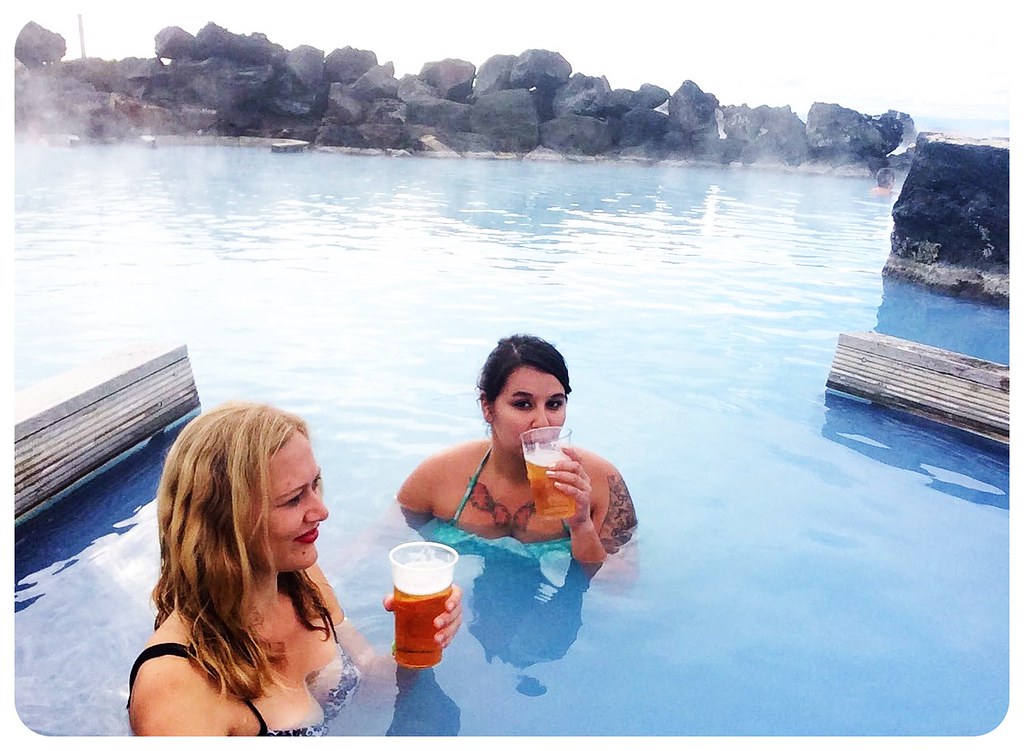 The sensation of sitting in hot waters (the pools range from 97°F to 104°F/36° to 40°C) while being hit in the face by a chilly breeze is something special, and being massaged by the in-water massage fountains after days of sitting in the car? Heavenly. This afternoon was a great way to end our time in Myvatn.
The sensation of sitting in hot waters (the pools range from 97°F to 104°F/36° to 40°C) while being hit in the face by a chilly breeze is something special, and being massaged by the in-water massage fountains after days of sitting in the car? Heavenly. This afternoon was a great way to end our time in Myvatn.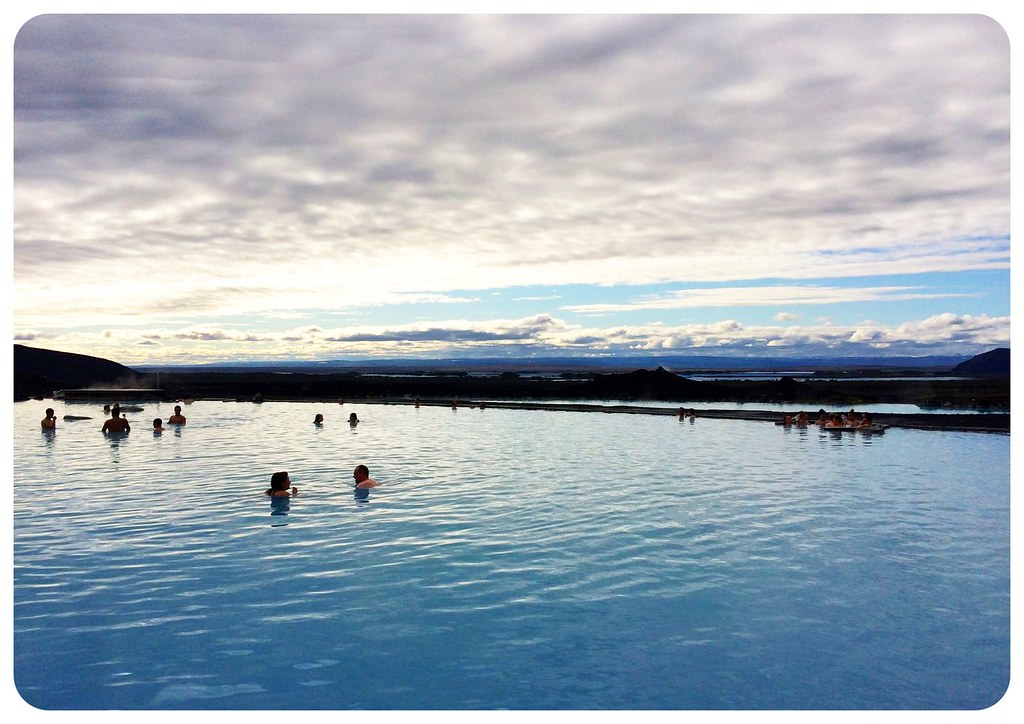 Tip: The baths are open until 10pm in the winter (and until midnight in the summer), and the northern lights can often be seen from here. So you might want to plan your visit for the late afternoon/evening hours. I can’t even imagine how cool it must be to watch the northern lights dance in the sky while soaking in the hot pools!
Tip: The baths are open until 10pm in the winter (and until midnight in the summer), and the northern lights can often be seen from here. So you might want to plan your visit for the late afternoon/evening hours. I can’t even imagine how cool it must be to watch the northern lights dance in the sky while soaking in the hot pools!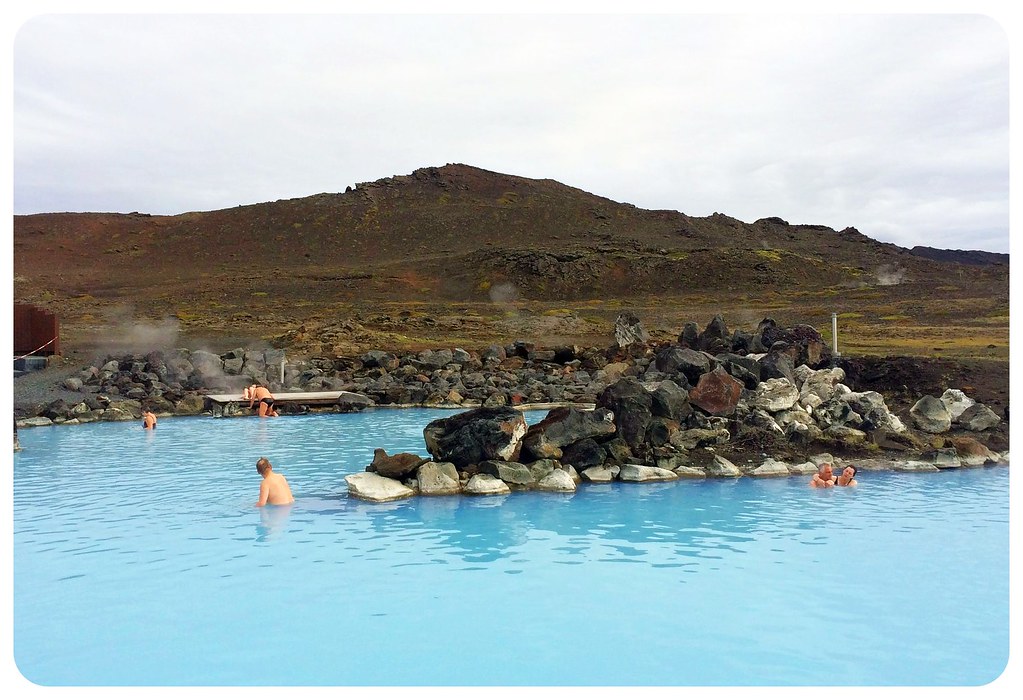
Godafoss Waterfall
The next morning, it was time for us to continue our trip towards Akureyri, the capital of the north, and further west to finish the circle back to Reykjavik. But we had one last stop: Godafoss, one of Iceland’s largest waterfalls. The waterfalls stand at 33 feet (10 meters), not very high, but the impressive width of 100 feet (30 meters) make up for what they are missing in height, and for me they were among the most majestic falls we saw in Iceland. The falls are a short detour from the Ring Road, but definitely worth it.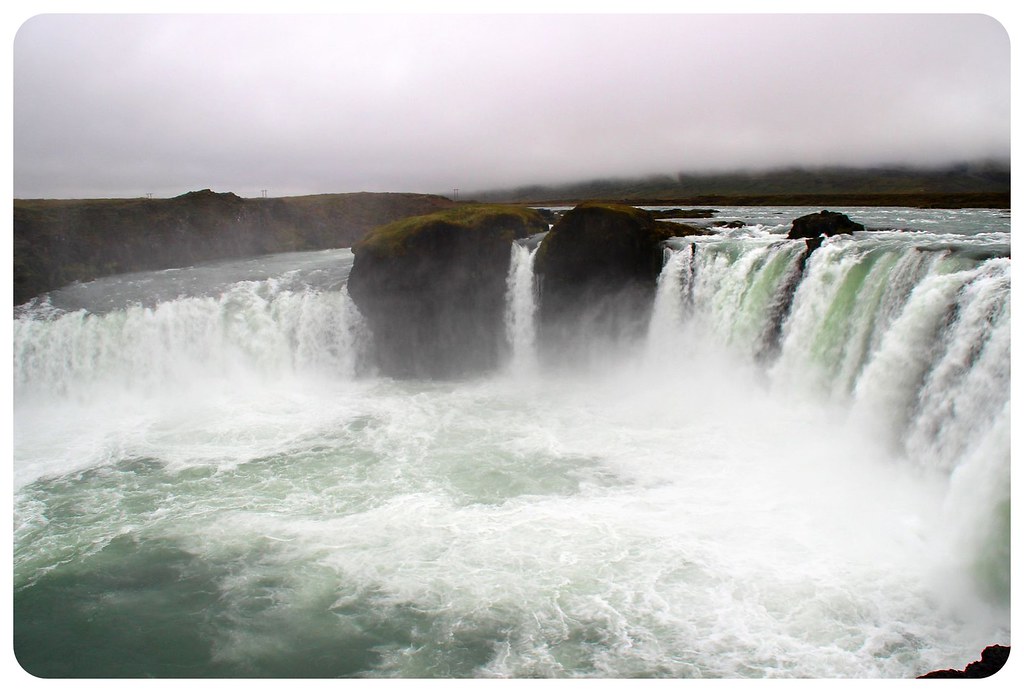 So far on our road trip, every day seemed to top the previous one, but I have to admit that after Myvatn, nothing could top what we’d seen there. That said, we didn’t have much time to explore the northwest of Iceland, and I am sure that had we had more time, we would’ve found some stunning places there as well. A place I was keen on visiting that we had to skip due to time restraints was the Snæfellsnes peninsula in western Iceland, for example, which is often referred to as a miniature version of the entire country, because you can see so many of the things that make Iceland special in this 56 miles (90km) long peninsula: volcanic craters, a stunning glacier (Snæfellsjökull), black sand beaches, mountain scenery and lush valleys, little fishing towns, picturesque lakes and fjords. If you don’t have enough time to drive the Ring Road, Snæfellsnes is a good alternative.
So far on our road trip, every day seemed to top the previous one, but I have to admit that after Myvatn, nothing could top what we’d seen there. That said, we didn’t have much time to explore the northwest of Iceland, and I am sure that had we had more time, we would’ve found some stunning places there as well. A place I was keen on visiting that we had to skip due to time restraints was the Snæfellsnes peninsula in western Iceland, for example, which is often referred to as a miniature version of the entire country, because you can see so many of the things that make Iceland special in this 56 miles (90km) long peninsula: volcanic craters, a stunning glacier (Snæfellsjökull), black sand beaches, mountain scenery and lush valleys, little fishing towns, picturesque lakes and fjords. If you don’t have enough time to drive the Ring Road, Snæfellsnes is a good alternative.
But to be honest – I wasn’t too upset that we didn’t make it there this time around, because it gives me just another excuse to return to Iceland.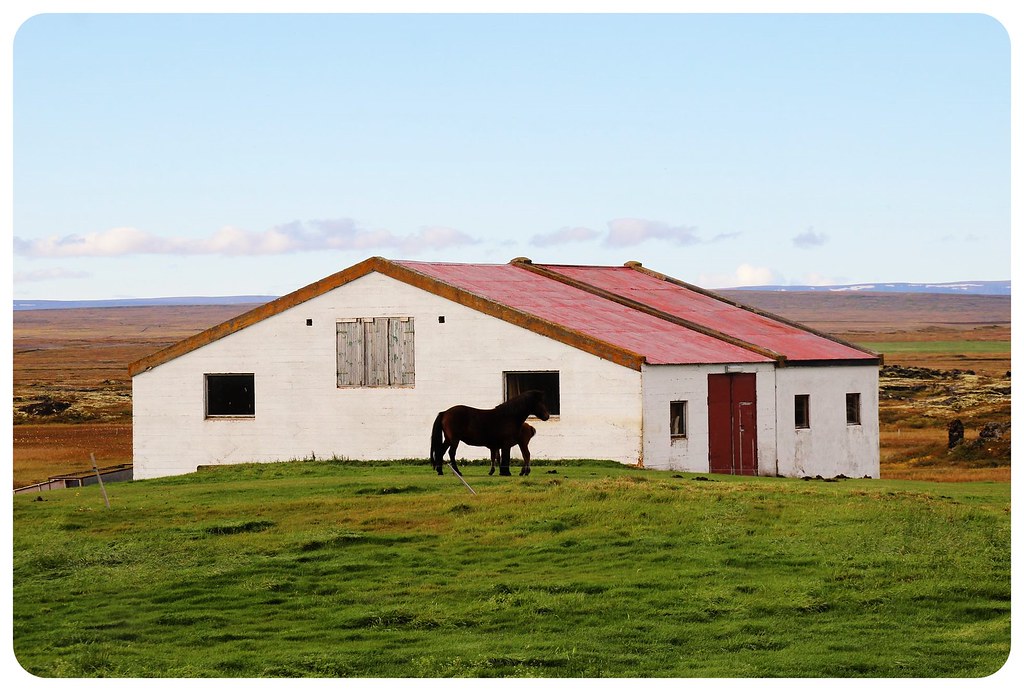
Sjáumst bráðlega, Heillandi Ísland!
I hope I’ll see you soon again, enchanting Iceland!
Planning a trip to Iceland? Check out this article:
For more of our epic road trip, read:
- The Most Epic Iceland Road Trip, Part I
- The Most Epic Iceland Road Trip, Part II (+ tips for driving in Iceland)
…or watch my Iceland road trip video…

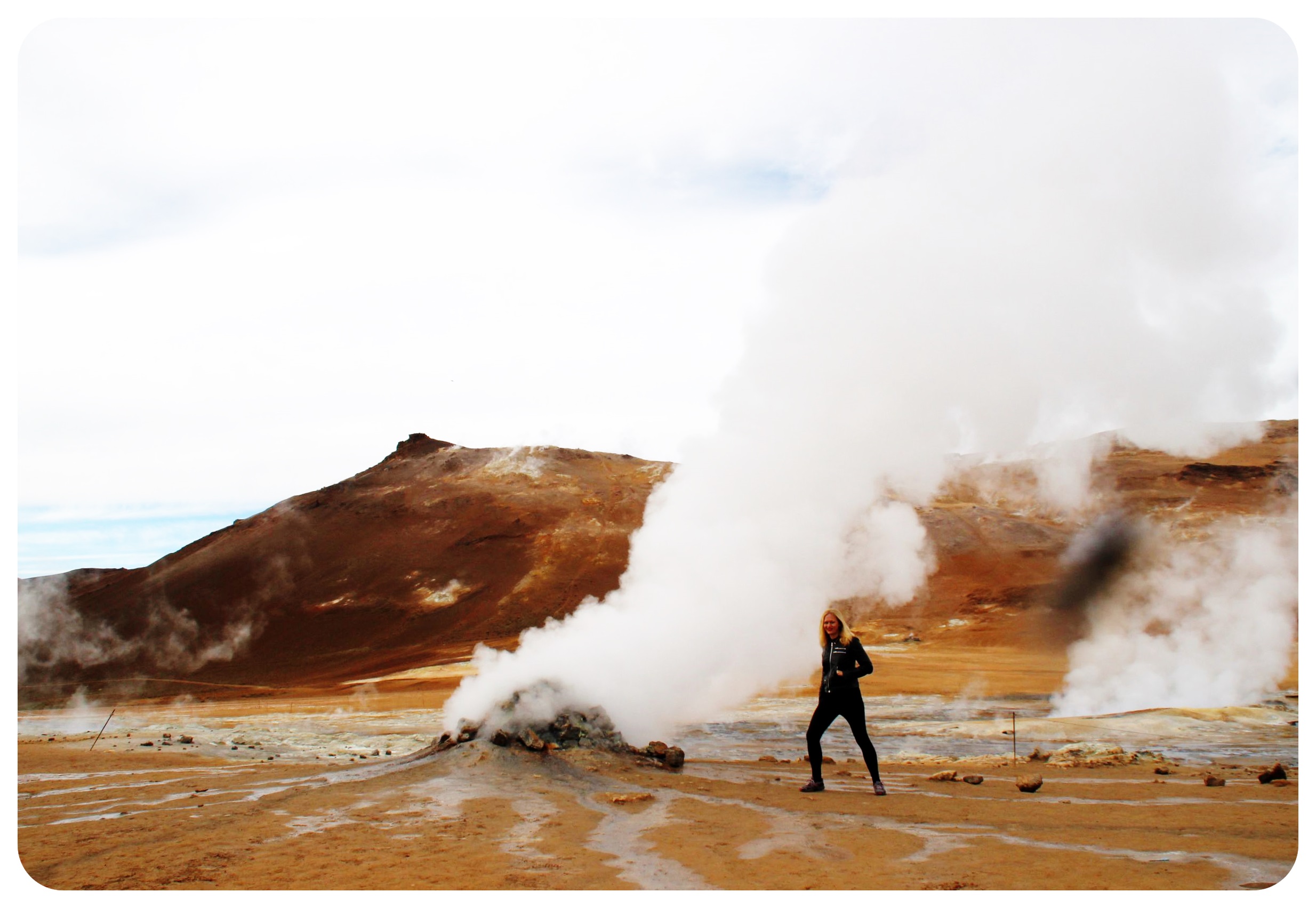
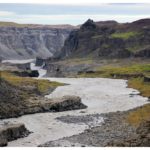

Allan
Wednesday 1st of June 2016
Great Read. Travel Blogs are generally not so cool. This one is different. Go G Girls
NoodleSoup
Saturday 28th of May 2016
I'm curious to know: what moth did your trip take place in? for how long were you in iceland?
Dani
Wednesday 13th of July 2016
I went in September, and I was there for a week. The weather was mixed - we had blue skies and sun but also rainy, grey days - but I wanted to go at a time when you could see the Northern Lights and after the summer tourist season had ended.
Jolene
Sunday 17th of April 2016
Those photos are sensational! Iceland is high on my list of places to see ASAP, every single time I see a photo, it just pulls me closer!
Dani
Friday 29th of April 2016
Thanks so much, Jolene! :)
David
Friday 1st of April 2016
Wow Beautiful Places to see,i like your photos,really that looks incredible,thanks for share your experience..
Lavina
Thursday 31st of March 2016
I had initially planned to visit Iceland for the polar lights but I'm so glad I chose Norway for that! We got a spectacular show!
I definitely wanna visit Iceland too and would love to see the lights again, but enjoying the landscape would be top priority :)
Loved your itinerary!
Cheers!
Dani
Saturday 9th of April 2016
Thanks, Lavina :) I want to go back to Iceland to see more of the landscapes!! And to climb a glacier :)